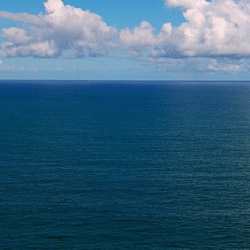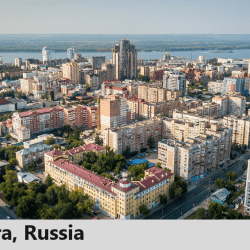The Atlantic Ocean is the world’s second largest ocean basin, covering an area of about 106,460,000 square kilometers (41,105,000 square miles). This equals roughly 20% of Earth’s surface.
Although massive, the Atlantic is only slightly more than half the size of the Pacific Ocean, which is the largest ocean basin on the planet.
How Big is the Atlantic Ocean?
- Area: ~106.4 million km² (41.1 million sq mi)
- Percentage of Earth’s Surface: 20%
- Volume (with bordering seas): ~354.7 million km³
- Average Depth: 3,339 meters (10,955 feet)
- Deepest Point: Milwaukee Deep near Puerto Rico, at 8,380 meters (27,490 feet)
Location and Boundaries
- West: Borders North and South America.
- East: Borders Europe and Africa.
- North: Connects to the Arctic Ocean.
- South: Connects to the Southern Ocean.
This central position has historically made the Atlantic vital for exploration, trade, and cultural exchange, linking the Old World and the New World.
Division of the Atlantic
Scientists typically divide the ocean into:
- North Atlantic – colder waters, home to powerful currents such as the Gulf Stream.
- South Atlantic – warmer waters, shaped by equatorial and subtropical currents.
The North Atlantic is especially important because it drives the global ocean conveyor belt, a massive circulation system that helps regulate Earth’s climate by redistributing heat around the globe.
Origin of the Name
The word Atlantic comes from Atlas, the Titan from Greek mythology who was said to hold up the sky. The name reflects the ocean’s vast and powerful nature.
The Atlantic Ocean: Size, Geography, and Importance Explained
How big the Atlantic Ocean is, its geography, history, and role in Earth’s climate system. Covering 20% of the planet’s surface, it is the second-largest ocean basin in the world.
Geographic Location and Boundaries
The Atlantic Ocean is uniquely placed between four major continents:
- West: North America and South America
- East: Europe and Africa
- North: Connected to the Arctic Ocean via the Denmark Strait, Greenland Sea, Norwegian Sea, and Barents Sea
- South: Linked with the Southern Ocean
- Connections:
- Strait of Gibraltar → connects to the Mediterranean Sea
- Drake Passage → connects to the Pacific Ocean
- Panama Canal → artificial link between Atlantic and Pacific
- 20th meridian east → marks its division with the Indian Ocean
Because of these connections, the Atlantic Ocean plays a central role in global navigation and trade.
North Atlantic vs. South Atlantic
Scientists divide the Atlantic into two main basins:
North Atlantic
- Known for strong currents like the Gulf Stream, which warms Europe.
- Site of the sinking of the RMS Titanic in 1912.
- Waters cool significantly near the Arctic, driving the global conveyor belt (thermohaline circulation) that regulates Earth’s climate.
South Atlantic
- Warmer waters shaped by equatorial currents.
- Less influential in climate regulation compared to the North Atlantic.
- Home to the South Atlantic Gyre, a major circulation system.
Geological History of the Atlantic Ocean
- The Atlantic was born from the breakup of the supercontinent Pangaea about 135 million years ago during the Cretaceous Period.
- Evidence of this lies in the way South America’s east coast fits against Africa’s west coast, supporting Alfred Wegener’s theory of continental drift.
- The Mid-Atlantic Ridge, a massive underwater mountain chain, continues to push the Americas westward, making the Atlantic Ocean grow wider every year.
Key Ocean Currents
The Gulf Stream
- Originates in the Caribbean Sea, flowing northeast toward Europe.
- Warms countries like France, the UK, Iceland, and Norway, making their winters milder than those in Canada at the same latitude.
- A critical part of the Atlantic Meridional Overturning Circulation (AMOC), which regulates global climate.
South Atlantic Currents
- Include the Brazil Current and the Benguela Current, but these have a smaller effect on climate compared to the Gulf Stream.
Geological Features of the Seafloor
- Mid-Atlantic Ridge: The most prominent feature, running north to south beneath the ocean.
- Tectonic Plates: The ridge marks the boundary between the Eurasian, North American, South American, and African plates.
- Volcanic Islands: Iceland and the Azores formed along this ridge.
- Trenches: Deep areas like the Puerto Rico Trench contain the ocean’s lowest points.
Salinity and Water Composition
- Salinity ranges from 33 to 37 parts per thousand.
- Varies by latitude, rainfall, evaporation, and river inflows.
- Major freshwater sources: Amazon River, Congo River, and Mississippi River.
Economic and Historical Importance
- Trade Routes: The Atlantic has been central to world exploration, from the voyages of Christopher Columbus to modern shipping lanes.
- Colonial History: It connected Europe, Africa, and the Americas during the Age of Exploration and later during the Atlantic slave trade.
- Fishing Grounds: Rich marine biodiversity supports commercial fisheries.
- Energy Resources: Offshore oil and gas reserves are significant in the North Sea, Gulf of Mexico, and West Africa.
Famous Shipwrecks
- RMS Titanic (1912): Lies at the bottom of the North Atlantic.
- Countless other vessels lost during wars, trade, and storms, making the Atlantic a graveyard of maritime history.

FAQs on Atlantic Ocean
1. How big is the Atlantic Ocean?
The Atlantic covers 106.4 million km², about 20% of Earth’s surface, making it the second-largest ocean.
2. Which ocean is bigger: the Atlantic or Pacific?
The Pacific Ocean is almost twice as large as the Atlantic.
3. Why is the Atlantic important for climate?
The Gulf Stream and global conveyor belt circulate heat, helping regulate Earth’s climate.
4. What is the deepest point in the Atlantic Ocean?
The Milwaukee Deep in the Puerto Rico Trench, at 8,380 meters (27,490 feet).
5. What continents border the Atlantic Ocean?
The Atlantic lies between North and South America (west) and Europe and Africa (east).
6. What is the Mid-Atlantic Ridge?
A massive underwater mountain chain caused by seafloor spreading, where the Atlantic is slowly widening.
The Atlantic Ocean is more than just water between continents—it is a crucial driver of climate, trade, and history. Covering one-fifth of the planet’s surface, it continues to shape human civilization through its resources, currents, and central geographic position. From the Gulf Stream’s warming influence to the Mid-Atlantic Ridge’s geological dynamism, the Atlantic is a living, breathing part of our planet.













